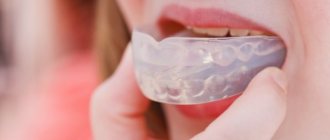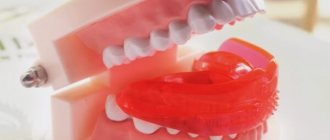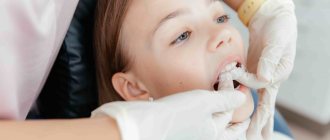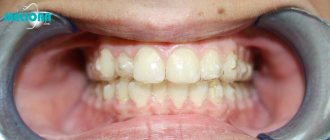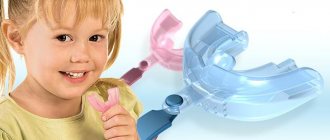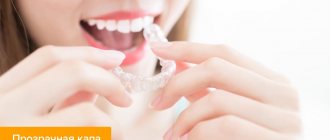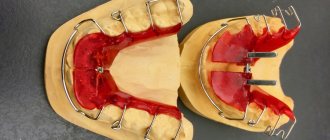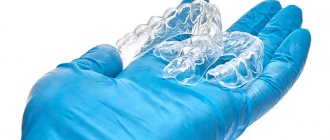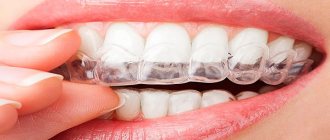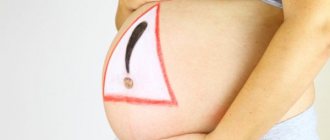Treatment of malocclusion is one of the most popular services in the dental department of the CELT clinic. Advanced orthodontic technologies used by our specialists are able to effectively correct dental anomalies. In case of minor malocclusions, our specialists use dental plates.
Having decided to install a dental plate, you will receive a removable or non-removable orthodontic system in the form of a metal arch with a plastic base made of hypoallergenic material. Its design provides for the presence of clamps. The purpose of the system is to apply gentle pressure and thus correct the dentition. To do this, it has a screw, which must be adjusted as you wear it. This approach allows you to increase the load on the dentition and apply more pressure.
Manufacturing of fixed and removable dental plates
carried out on an individual basis, and they themselves allow:
- adjust the position of the incisors;
- increase or decrease the width of the palate;
- adjust the shape of the jaw;
- accelerate or slow down jaw growth depending on the identified defects.
At CELT you can get advice from a dental specialist.
- The cost of an orthodontist consultation is 2,000
Make an appointment
Indications
In the vast majority of cases, dental plates are used to correct teeth in children under the age of twelve. It is during this period that intensive development of the jaws occurs, due to which the treatment will be as effective as possible. During this period, indications for use are:
- malocclusion;
- incorrect position of teeth;
- crowding or large spaces between teeth;
- too slow or, on the contrary, intense jaw growth.
Plates for teeth
It is also used for treatment in
adults
. In this case, the indications are as follows:
- maintaining the results of orthodontic treatment using braces;
- insignificant alignment of teeth within the dentition.
It is worth noting that competent and timely use of dental plates in childhood gives excellent results - and this despite the fact that its price is much lower than braces! This is why we recommend that parents seek treatment on time: you will not only save money, but also eliminate discomfort for your children (after all, plates are not as noticeable on the teeth as braces).
Contraindications
Orthodontic plates have a minimum of contraindications. So, the absolute ones relate to the following:
- individual intolerance to the materials from which structural elements are made;
- dental periodontal disease, in which there is atrophy of bone tissue and a decrease in the height of the interdental septa;
- diseases of the respiratory system.
There are also relative contraindications. These are carious lesions of the teeth: before applying the plates, they must be eliminated.
What are dental plates?
An orthodontic plate for teeth is a removable structure made of soft plastic and wire. This device is made individually from hypoallergenic materials and is not traumatic to the oral mucosa. Plates for straightening teeth can be either single- or double-jawed, depending on the diagnosis. They can be supplemented with a “hand-shaped process”, which is used to move only one tooth. The device may also contain a retraction arch designed to correct the position of the front teeth. Separate types of plates for teeth are Brückle and Frenkel devices. Look at the photo below to see what the plate looks like on your teeth.
Indications for use
The device is installed if necessary:
- prevent possible displacement of teeth, keep them in the correct, natural position;
- adjust the shape of the jaw bones or the width of the palate;
- expand interdental distances, get rid of crowding (in children);
- consolidate the result after wearing braces;
- slow down bone growth.
There are also contraindications, but they are few:
- severe mental disorders;
- some respiratory tract disorders;
- allergy to the metal from which the device is made;
- exacerbation of periodontal diseases.
If the oral cavity is not sanitized, there are caries, problems with the gums, the enamel looks bad: before you start wearing a child or adult plate to straighten teeth, you need to get rid of concomitant diseases.
Types of dental plates
Depending on the diagnosis, the doctor determines the types of dental plates. In some cases, only a plate is installed for the teeth of the lower jaw. This design refers to mechanically operating devices, that is, its action depends on the elasticity of the component parts. They use the force of an orthodontic screw, wire, ligature, or rubber ring. To increase space in the dentition at the stage of mixed dentition, an expanding plate for the teeth of the upper jaw, based on a Bertoni screw, is also used. The screw is installed on the working model of the jaw in the deep part of the dome of the palate so that it is parallel to the occlusal plane. This design needs to be tightened from time to time; we will tell you how to do this a little later.
Plastic surgery for lower jaw teeth
Upper jaw plate
How long should I wear it?
The period of wearing orthodontic plates is individual for each patient. In most cases, the wearing time depends on the complexity of the problem that the device is intended to solve.
Before starting treatment, even an experienced doctor can only give an approximate time. In this case, the exact time of removal can only be determined during wearing , when the first results begin to appear.
The average period is about one and a half years. However, it can vary from about a few months to 2–3 years. The plates themselves may also change during the treatment process, depending on the results obtained and how the current situation has changed.
When should a plate be placed on a child’s teeth?
The dental plate is not suitable for adult patients. This is an exclusively children's orthodontic device. First of all, plates for straightening teeth in children are used up to 12 years of age. During this period, there is active growth of the jaws, which makes it possible to quite effectively correct the bite, eliminate crowding and remove other occlusion anomalies. When the jaw bones have formed, it is only possible to align the teeth within the dentition. And correction of bite in adult patients is only possible with the help of braces and orthognathic surgery. In this regard, parents should not delay visiting a specialist, even if it is a preventative one, if treatment is not required. Orthodontists recommend placing a plate on a child’s teeth to achieve the following treatment goals:
- correction of jaw shape;
- regulation of jaw growth;
- correct placement of incisors in a row;
- increasing or decreasing the size of the sky.
The main causes of malocclusion
In children, the cause of the development of malocclusion is most often the untimely loss of baby teeth, which impedes the growth of molars, as well as delayed growth of the latter due to “licking”. Parents are obliged to control this process, ensuring that it occurs within the prescribed time frame, if violated, it is necessary to contact the dentist in a timely manner.
The specialist will remove the baby tooth or slightly spread the gum tissue, helping the molar to erupt. Otherwise, “violation of the schedule” leads to the curvature of not only the delayed tooth, but also those standing next to it, and then the entire dentition. Also, uneven teeth can grow due to disruption of the process of proper development of the jaw bones.
Here you can find out how much it costs to put plates on your teeth. In some cases, malocclusion can lead to diseases such as dentin caries.
Sometimes malocclusion can begin to form in adults whose teeth previously grew normally. In this case, the cause is the “wisdom tooth,” which is the last one to erupt and often grows unevenly, pressing on the remaining teeth in the row and causing them to become crooked. In this case, the dentist recommends removing it as soon as possible.
Another reason for crooked teeth in adults is untimely prosthetics after extraction, which causes the teeth to shift towards the resulting void.
How to place a plate on a child’s teeth?
Installing plates on children's teeth usually takes several weeks, since they are made individually for each patient. To create a suitable orthodontic appliance, the patient undergoes an X-ray examination, then the doctor takes an impression of the teeth for the plate. After this, plaster models are made, from which the structures are created. Particular attention is paid to the exact match of the surface relief of the gums and the palate - the adjustment takes just over 10 minutes. After this, the child will be able to independently remove and put on the plate on the lower teeth and upper jaw.
What are records for?
The most common problems in orthodontics include violations of the position of the teeth and the closure of the dentition (bad bite), which occur in childhood.
Causes of malocclusion in children:
- hereditary factor;
- bad habits (prolonged sucking of a pacifier, finger or pencil)
- mouth breathing (presence of adenoids, deviated nasal septum)
- poor posture.
And in older age, these disorders can result from difficult eruption of wisdom teeth, periodontal disease, and also as a result of tooth loss.
Plates on baby teeth solve the following problems:
- straighten teeth;
- correct malocclusions;
- hold space from previously extracted teeth;
- adjust the width of the palate;
- create conditions for the correct formation of the bite and development of chewing teeth;
- change the position of the jaw;
- improve nasal breathing;
- help get rid of bad habits that affect the bite (if a child sucks a finger or bites his lip).
Children quickly get used to dental plates and do not feel discomfort when wearing them. If the structure breaks, it can always be repaired. The parents' task is to control that the child takes it off and puts it on in a timely manner, because it only works when it is in the mouth.
How long do you wear plates on your teeth and how to wear them?
The main problem with this type of treatment is that children need to wear removable dental plates 22–23 hours a day. The course of treatment can last from a year to a year and a half, with replacement of the structure required every 6 to 8 months. Like any orthodontic device, plates for baby teeth require some getting used to. Children often complain that their teeth hurt from the plate; this is normal. Usually the discomfort disappears 5 to 6 days after installation.
Wearing dental plates often confuses children, but it is worth explaining to the child that they are less noticeable and more comfortable than metal braces, which will have to be worn in adolescence without timely treatment. Children's dental plates are often made of plastic in bright colors so that the child enjoys wearing them.
Differences between removable and permanent braces
The first can be considered a lightweight option. Such arcs:
- cheaper than those that cannot be removed independently;
- not very effective for noticeable problems, more suitable for maintenance therapy.
What does a removable dental plate look like? This is a structure made of soft plastic, it is attached to metal hooks by the teeth. Children's options are often decorated with sparkles or made colorful to make them more pleasant for the child to use.
An undoubted advantage is that this option can not be worn all the time, getting rid of the device during meals, and in some cases during sleep (as prescribed by a doctor). However, they need to be used as often as possible, otherwise there will be no visible effect: sometimes even a break of one day significantly complicates the treatment.
How to tighten a dental plate?
The twisting procedure is necessary to increase the load, as well as expand the main surface of the plate, which is installed on the upper jaw. Your doctor will tell you how to tighten the dental plate and how often to do it. The process itself is not too complicated: using a key inserted into the main hole of the screw, one turn is made along the guide arrow on the tooth plate. After this, the child may feel discomfort for some time, but this procedure is necessary to achieve the desired result. In addition, if necessary, the plate can be returned to its previous position by turning back.
Dental plastic with a key for twisting
Device and principle of operation
Despite the existing differences in the structure of orthodontic plates, they all have a similar design and main structural components. The base is a plastic base. It is connected in a certain way to metal arches of various configurations.
It is these arcs that serve as the main acting force for adjustment. In addition, the design also includes fasteners that serve to hold the plate in the correct position on the patient's jaw. Fastenings can be in the form of hooks.
In some types, in addition to this, a special screw is also required, which activates the device using a key.
The principle of action is to apply constant, low-intensity pressure to the dentition, returning it to the correct position or preventing the situation from getting worse.
Children's dental roots cannot be damaged because the pressure is very low.
How to care for a dental plate?
When wearing a removable structure, the child needs to handle it carefully and avoid damage or loss, as well as properly care for it. You need to remove the plate from your teeth before each meal and be sure to clean it every day with a special brush and gel. It is better to store records in a container. Particular attention must be paid to the little patient’s own oral hygiene. That is why dentists usually give a short lecture to the child, in which they explain all the rules for handling this structure.
Container for dental plates
How to install?
After the initial examination, an x-ray is taken, without which it is impossible to prescribe the wearing of orthodontic appliances . If it is necessary to use orthodontic plates for correction, the doctor follows a certain algorithm.
- Before installation, the plate must be manufactured. Since these devices must be strictly individual, it is necessary to make an impression of both jaws of the patient.
- A primary model is then made from plaster and tried on to eliminate even the most minor discrepancies.
- The model serves as the basis for the manufacture of both the plastic base of the plate and other parts. The shape of the plastic should repeat in great detail all the individual features of the palate, as well as the contours of the teeth and gums.
- The penultimate stage is the fitting of the finished product, based on the results of which the doctor can make its correction.
- Since the plates are removable structures, their direct installation does not cause problems. However, the first installation at the dentist's office is important, as the dentist will teach you how to put on and take off the appliance yourself so as not to damage it or harm your teeth.
Plates or braces for teeth?
This choice cannot stand - dental plates and braces have different functions. The former affect the entire dentition, the latter have a wide range of functions and solve various orthodontic problems: from the curvature of individual teeth to malocclusion and crowding. Also, the plate cannot be placed if the child has developed traumatic periodontitis, in which a fracture of the cortical plate of the tooth is possible. However, these two devices can be used in combination - first the child will be given a plate, and then braces.
What is better or worse than braces?
It is hardly worth comparing braces and orthodontic plates, since they perform different functions and have different indications for installation . At the same time, we can name the advantages and disadvantages of the plates, which will help many patients make their choice.
Advantages:
- the possibility of installation in childhood, when the jaw system is not yet fully formed;
- often shorter wearing period;
- removable design gives more freedom and comfort to the patient;
- do not cause pain.
Flaws:
- cannot be used in complex cases of malocclusion;
- it is not possible to make precise adjustments to the position of each tooth;
- cannot always help adult patients, since their tooth mobility is greatly reduced due to the completion of the formation of the dentofacial system.
The cost of a dental plate in Moscow
The average cost of dental plates for children in Moscow varies from 8 to 15 thousand rubles. Do not forget that the design requires periodic correction and replacement, so visits to the doctor must be included in the total cost. You should also take into account other factors that affect the price, for example, the level of pediatric dentistry and the qualifications of specialists. In any case, you shouldn’t go after cheapness; the cost of dental plates for children should not be too low - the child’s health is more expensive.
Types for children
For children's teeth, all types and types of structures that are listed above are used.
Frenkel apparatus
Consists of plastic lip pads and cheek shields (2 of each element). They are connected using a durable metal frame, which can take the form of a palatal clasp, lingual or vestibular arch. Moves the anterior teeth using a springy retraction arch and masticatory muscles.
photo: Frenkel apparatus
Price – from 11.5 to 22 thousand rubles.
Andresen-Goipl activator
Consists of two base plates connected into a single block. May have screws, retraction arch, and other components. Helps activate jaw growth if necessary, uncouples the bite, and also returns individual teeth to their correct position.
photo: andresen-goipl activator
Price – from 12 thousand rubles.
The cost of each type in this case may be even higher than for plates for adults. This occurs due to the child’s choice of the pattern configuration and the variety of colors that will be present on the plate base of the device.
Modern technologies make it possible not only to make the plate itself multi-colored, you can also add glitter, all kinds of decorations and designs to the plastic.
The average cost of a plate for one jaw will be about 8 thousand rubles. But a simple plate for one jaw without additional functional elements, such as screws, costs about 3-4 thousand.
Types of plates for correcting bite
There are removable and permanent models. Many types of devices are used to correct bites and individual teeth.
The following types of structures are distinguished:
- single-jawed;
- apparatus with a hand-shaped process;
- models with a retraction arc;
- expanding plate with push block;
- devices of various author's modifications.
These devices are removable designs. They are more often used due to their greater convenience and functionality.
Features of work and treatment process
I wonder how the treatment works? Is it effective or is it just another advertising ploy from manufacturers? Unlike braces, this system combats existing oral defects more gently and painlessly.
To correct an incorrect bite, it is not necessary to install plates or wear a braces system for a long period with difficult adaptation. It is enough to simply wear silicone mouth guards at night for aesthetics and greater comfort.
Trainers are an effective system for correcting dentition and identifying jaw defects in adults and children. Of course, the stages of treatment and the cap model for adults are, of course, different from the pediatric program. The main advantages of this new product are comfortable wear and occasional use, and it is easy to care for.
During treatment, the patient's malocclusion is corrected, impaired breathing or swallowing is normalized, and the tongue is in the correct position for clear diction. The design forces the muscles to take the correct position and get used to it. Using this technique, you can quit bad habits and put your daily routine in order, since the wearing process follows a clear schedule and night use will require 8 hours of sleep.
For adults, these trainers will help correct minor defects or as part of complex treatment with a brace system to solve more complex problems.
While wearing the mouthguard, you should not talk, drink or eat. The patient must adhere to a schedule for wearing the trainers.
For more serious oral abnormalities, comprehensive treatment is recommended.
